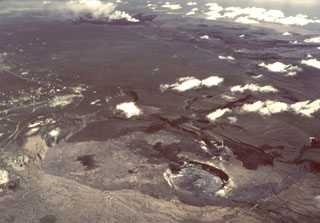Report on Kilauea (United States) — 30 April-6 May 2014
Smithsonian Institution / US Geological Survey
Weekly Volcanic Activity Report, 30 April-6 May 2014
Managing Editor: Sally Sennert.
Please cite this report as:
Global Volcanism Program, 2014. Report on Kilauea (United States) (Sennert, S, ed.). Weekly Volcanic Activity Report, 30 April-6 May 2014. Smithsonian Institution and US Geological Survey.
Kilauea
United States
19.421°N, 155.287°W; summit elev. 1222 m
All times are local (unless otherwise noted)
During 30 April-6 May HVO reported that the circulating lava lake occasionally rose and fell in the deep pit within Kilauea's Halema'uma'u Crater. Gas emissions remained elevated. The plume from the vent continued to deposit variable amounts of ash, spatter, and Pele's hair onto nearby areas; smaller particles may have been dropped several kilometers away.
At Pu'u 'O'o Crater, glow emanated from spatter cones on the N and S portions of the crater floor, and from the lava pond in the NE spatter cone. The S spatter cone periodically erupted lava flows that traveled N and SE beyond the crater rim. During 5-6 May the N cone ejected spatter and a small lava flow. The Kahauale’a 2 lava flow continued to advance, with breakouts from the main stalled lobe, and burned adjoining forest. On 5 May geologists mapped the farthest point of activity, 8.6 km NE of Pu’u 'O'o.
Geological Summary. Kilauea overlaps the E flank of the massive Mauna Loa shield volcano in the island of Hawaii. Eruptions are prominent in Polynesian legends; written documentation since 1820 records frequent summit and flank lava flow eruptions interspersed with periods of long-term lava lake activity at Halemaumau crater in the summit caldera until 1924. The 3 x 5 km caldera was formed in several stages about 1,500 years ago and during the 18th century; eruptions have also originated from the lengthy East and Southwest rift zones, which extend to the ocean in both directions. About 90% of the surface of the basaltic shield volcano is formed of lava flows less than about 1,100 years old; 70% of the surface is younger than 600 years. The long-term eruption from the East rift zone between 1983 and 2018 produced lava flows covering more than 100 km2, destroyed hundreds of houses, and added new coastline.
Source: US Geological Survey Hawaiian Volcano Observatory (HVO)

